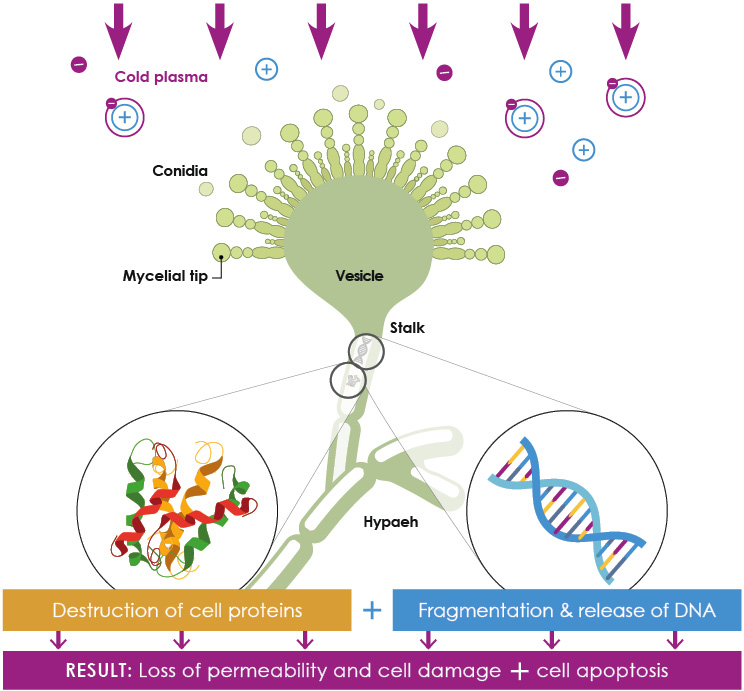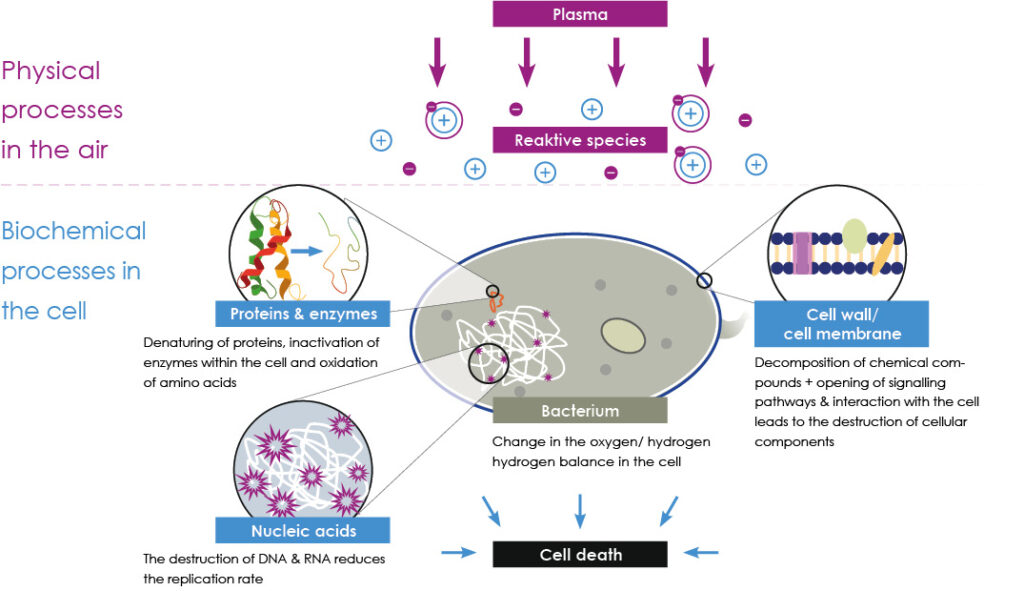PLASMA
Plasma from space - a reactive bundle of energy.


Cold atmospheric plasma is a partially ionized gas.
Solid, liquid, gaseous – these are the well-known states of aggregation.
When ice and water are heated, they change their physical state of aggregation: ice melts and water evaporates. In a similar way, almost every matter changes its physical state when enough energy is supplied.
If additional energy is added to a gas, plasma is produced. This process leads to ionization of the molecules.
Plasma thus describes the forth high-energy state of matter in which gas is (partially) ionized.

Natural plasma is produced by phenomena such as lightning or the Northern Lights, i.e. the plasma found in nature is far too hot to be applied directly to living beings. It was only through the technical development of cold atmospheric plasma, i.e. plasma at room temperature and under atmospheric pressure, that the application on human skin make possible.
But how does an extremely hot gas mixture become cold plasma? To obtain cold plasma, a gas is supplied with just enough energy that it is only partially ionized (a particle of 10⁹ is ionized). This allows the temperature to be controlled so that it remains below 40°C.
This process triggers a cascade of chemical reactions that produce a so-called plasma cocktail consisting of light, heat, some ultraviolet radiation, electromagnetic fields, free electrons, ions and excited molecules – the so-called reactive species. This cocktail is poison for bacteria, including multi-resistant pathogens, and stimulates cell division in healthy human cells.
This means that the proportion of reactive species is particularly high, because these represent the medically effective part of the plasma cocktail. On the other hand, the proportion of visible light, UV and heat radiation is minimized.


Cold plasma deactivates bacteria, fungi, viruses and also multi-resistant pathogens. It activates cell growth, blood circulation and cell metabolism and thus stimulates wound healing.
Read more details on the topic:
How does CAP work in wound treatment?
If the previously described plasma cocktail with a high proportion of reactive species encounters bacteria or multi-resistant pathogens (MRE for short), then the cellular structures including the DNA are destroyed. If the DNA is destroyed, these microorganisms cannot multiply further - fortunately this also applies to antibiotic-resistant bacteria.
Even allergies and intolerances do not play a role in the treatment. A similarly good effect of cold plasma has also been demonstrated in many fungi and viruses.
In cold plasma application with plasma care, the treatment time of 60 seconds runs more than 600 reactions. All are important for the treatment of wounds.
The most important processes in the cell at a glance:

Most fungal infections are difficult to treat because fungi and spores have very resistant structures.
In addition to the bactericidal effect of CAP, including multi-resistant bacteria, fungi can also be inactivated by applying cold plasma. Fungi are eukaryotes, which means that they have a nucleus that contains their DNA.
Treatment with CAP deforms the spores of fungi, which leads to breaking, flattening and shrinkage of the same. Likewise, the DNA within the spores can be destroyed. Reactive oxygen species (ROS) trigger various reactions in fungi. Depending on the dose, these can lead to the oxidation of intracellular membranes and proteins up to structural changes inside the cells and in the further course to apoptosis (programmed cell death).

The effect is quite different in healthy human cells. These cells are much better protected than bacteria due to their cell network. In them, survival mechanisms are stimulated by the reactive species and cell division is stimulated. For wound healing, this means in concrete terms:The release of growth factors promotes cell renewal. The stimulation of angiogenesis leads to better blood circulation and, together with the improved cell metabolism, promotes wound closure or healing of the skin.
Cold plasma has no harmful effect on healthy cells and does not change the genetic material.

Various in vitro and in vivo studies show that cold atmospheric plasmas are highly efficient inactivating bacteria (including multi-resistant germs) without side effects. Eukaryotic (human) tissue is not damaged.
plasma care® works with “tamed” high voltage to generate the cold plasma from the ambient air – which of course also means that safety has a special priority for us:
1. Zimmermann, J. L. et al. Test for bacterial resistance build-up against plasma treatment. New J. Phys. 14, 073037 (2012).
2. Maisch, T. et al. Decolonisation of MRSA, S. aureus and E. coli by cold-atmospheric plasma using a porcine skin model in vitro. PloS One 7, e34610 (2012).
3. Heinlin, J. et al. Contact-free inactivation of Trichophyton rubrum and Microsporum canis by cold atmospheric plasma treatment. Future Microbiol. 8, 1097–1106 (2013).
4. Daeschlein, G. et al. Skin and wound decontamination of multidrug-resistant bacteria by cold atmospheric plasma coagulation. J. Dtsch. Dermatol. Ges. J. Ger. Soc. Dermatol. JDDG 13, 143–150 (2015).
5. Bunz, O. et al. Cold atmospheric plasma as antiviral therapy – effect on human herpes simplex virus type 1. J. Gen. Virol. 101, 208–215 (2020).
6. Isbary, G. et al. Randomized placebo-controlled clinical trial showed cold atmospheric argon plasma relieved acute pain and accelerated healing in herpes zoster. Clin. Plasma Med. 2, 50–55 (2014).
7. Lee, J. et al. Fast and easy disinfection of coronavirus-contaminated face masks using ozone gas produced by a dielectric barrier discharge plasma generator. http://medrxiv.org/lookup/doi/10.1101/2020.04.26.20080317 (2020) doi:10.1101/2020.04.26.20080317.
8. Arndt, S., Unger, P., Berneburg, M., Bosserhoff, A.-K. & Karrer, S. Cold atmospheric plasma (CAP) activates angiogenesis-related molecules in skin keratinocytes, fibroblasts and endothelial cells and improves wound angiogenesis in an autocrine and paracrine mode. J. Dermatol. Sci. 89, 181–190 (2018).
9. Maisch, T. et al. Investigation of toxicity and mutagenicity of cold atmospheric argon plasma. Environ. Mol. Mutagen. 58, 172–177 (2017).
10. Boxhammer, V. et al. Investigation of the mutagenic potential of cold atmospheric plasma at bactericidal dosages. Mutat. Res. 753, 23–28 (2013).
11. Isbary, G. et al. Cold atmospheric argon plasma treatment may accelerate wound healing in chronic wounds: Results of an open retrospective randomized controlled study in vivo. Clin. Plasma Med. 1, 25–30 (2013).
12. Heinlin, J. et al. Randomized placebo-controlled human pilot study of cold atmospheric argon plasma on skin graft donor sites. Wound Repair Regen. Off. Publ. Wound Heal. Soc. Eur. Tissue Repair Soc. 21, 800–807 (2013).
Quelle Wirkweise Pilze:
1. Maisch, T. et al. Decolonisation of MRSA, S. aureus and E. coli by cold-atmospheric plasma using a porcine skin model in vitro. PloS One 7, e34610 (2012).
2. Becker, S. et al. Effects of cold atmospheric plasma (CAP) on bacteria and mucosa of the upper aerodigestive tract. Auris. Nasus. Larynx 46, 294–301 (2019).
3. Isbary, G. et al. A first prospective randomized controlled trial to decrease bacterial load using cold atmospheric argon plasma on chronic wounds in patients. Br. J. Dermatol. 163, 78–82 (2010).
4. Zimmermann, J. L. et al. Test for bacterial resistance build-up against plasma treatment. New J. Phys. 14, 073037 (2012).
5. Heinlin, J. et al. Contact-free inactivation of Trichophyton rubrum and Microsporum canis by cold atmospheric plasma treatment. Future Microbiol. 8, 1097–1106 (2013).
6. Shapourzadeh, A. et al. Inhibitory effects of cold atmospheric plasma on the growth, ergosterol biosynthesis, and keratinase activity in Trichophyton rubrum. Arch. Biochem. Biophys. 608, 27–33 (2016).
7. Daeschlein, G. et al. In Vitro Killing of Clinical Fungal Strains by Low-Temperature Atmospheric-Pressure Plasma Jet. IEEE Trans. Plasma Sci. 39, 815–821 (2011).
8. Kaloriti, D. et al. Mechanisms Underlying the Exquisite Sensitivity of Candida albicans to Combinatorial Cationic and Oxidative Stress That Enhances the Potent Fungicidal Activity of Phagocytes. mBio (2014) doi:10.1128/mBio.01334-14.
9. Misra, N. N., Yadav, B., Roopesh, M. S. & Jo, C. Cold Plasma for Effective Fungal and Mycotoxin Control in Foods: Mechanisms, Inactivation Effects, and Applications: Cold plasma for effective fungal…. Compr. Rev. Food Sci. Food Saf. 18, 106–120 (2019).
10. Arndt, S., Unger, P., Berneburg, M., Bosserhoff, A.-K. & Karrer, S. Cold atmospheric plasma (CAP) activates angiogenesis-related molecules in skin keratinocytes, fibroblasts and endothelial cells and improves wound angiogenesis in an autocrine and paracrine mode. J. Dermatol. Sci. 89, 181–190 (2018).
11. Hasse, S. et al. Induction of proliferation of basal epidermal keratinocytes by cold atmospheric-pressure plasma. Clin. Exp. Dermatol. 41, 202–209 (2016).
12. Arndt, S. et al. Cold atmospheric plasma (CAP) changes gene expression of key molecules of the wound healing machinery and improves wound healing in vitro and in vivo. PloS One 8, e79325 (2013).
There are many questions about cold plasma therapy: Which bacteria does cold plasma affect? How long does the therapy last? …. We ccompiled the most frequently asked questions and answers for you here. You are also welcome to contact us directly.

terraplasma medical GmbH
Parkring 32
D-85748 Garching bei München
Tel: +49 89 5880 553-0